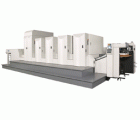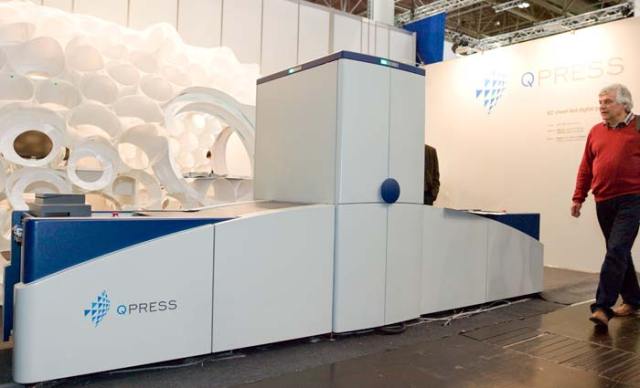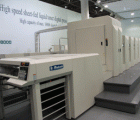
Punters looking to put their money on one overriding theme for the upcoming German trade show would get good odds on the “B2 Digital Drupa”.
Large-format inkjet and toner-based digital presses will be on show from traditional digital vendors such as HP, Fujifilm, Screen and MGI, as well as the likes of Komori, Ryobi and KBA. There will also be an “entirely new” digital process on the stand of Landa Corporation, the new venture of Indigo creator Benny Landa.
HP’s fourth-generation Indigo range comprises two new sheetfed presses – the B2-format 10000 for commercial print and the 30000 for folding carton applications – along with the 20000, a continuous-feed machine for flexible packaging.
The 10000 can reach speeds of 3,450 sheets per hour and the B2 format means the image size is 2.5 times larger than the existing Indigo maximum. Its duty cycle will be 2.2 million A4 pages per month.
French manufacturer MGI said the market “is ready for B2 inkjet” after announcing its foray with the Alphajet. At Drupa, it will showcase a working prototype of the new sheetfed machine.
The Alphajet can print at up to 1,200dpi and has a top speed of 3,000 A4 sheets an hour. The six-colour press can UV coat inline; functionality that the manufacturer said sets it apart from rival machines.
The Alphajet, which offers full variable data printing, can print onto substrates up to 500gsm and offers a maximum sheet size of 520x740mm.
One of the first manufacturers to go for the B2 format was Fujifilm, giving it a headstart on rivals. Drupa 2012 will mark the commercial launch of its Jetpress 720, first shown as a concept at Drupa 2008.
The Japanese vendor will also demonstrate a prototype folding carton press using the same inkjet technology.
The four-colour packaging press will use similar technology to the Jetpress, printing up to 1,200dpi resolutions on heavier substrates up to 0.4-0.5mm thick.
Inkjet may be the dominant theme but HP is not the only company with a different take on B2 digital.
Xeikon has pointed toward a top-secret large-sized digital press that uses the familiar toner technology found in smaller-format digital machines.
The Quantum will offer the same 1,200dpi quality of Xeikon’s 8000 Series LED array-based, electrophotographic printers, but at a running cost and speed similar to high-speed inkjet presses.
Xeikon is keeping its cards close to its chest until Drupa but did reveal that the technology used in Quantum was developed over some 50 years by a firm Xeikon stealthily acquired two years ago.
Landa creates entirely new form of digital
Indigo founder Benny Landa has lifted the lid on his top-secret nano printing breakthrough, claimed to offer “the lowest cost-per-page digital images in the industry”.
The new technology can produce images that are “about half the thickness of offset images”, according to Landa Corporation.
Chief executive Landa said it had taken 10 years of research to produce his “breakthrough”. The result is a series of sheetfed and web presses to be unveiled at Drupa.
“These include B3, B2 and B1 sheetfed perfecting presses that operate at up to 11,000 sheets per hour for commercial and packaging printing as well as web presses for publishing and flexible packaging that range in width from 52cm to 104cm and operate at up to 200 metres per minute.
“Such performance places Landa nanographic printing presses squarely in the heart of mainstream commercial printing.
“For the first time, commercial printers don’t have to choose between the versatility and short-run economics of digital printing and the low cost-per-page and high productivity of offset printing. Now they can have both.”
The printing process is based around the nano-pigments within Landa NanoInk.
Offset manufacturers dive into the digital fray
KBA, Komori, Heidelberg and Ryobi will all show digital machinery on their booths.
Heidelberg is sticking with the tried-and-tested A3 size with its digital ambitions, and has favoured the sales partnership approach. It is set to lock in a truly global deal with Ricoh after ending its two-year local relationship with Konica Minolta.
The company’s digital offerings will be formalised under the brand ‘Linoprint’, which comprises an inkjet device for labels and two rebadged Ricoh machines, which are both toner-based digital colour devices.
KBA and Komori have both signalled the intention to show proprietary digital machines, rather than rebadged engines.
KBA’s RotaJET 76 inkjet web has been designed with an innovative paper path that doesn’t require any turner bars, which contributes to a small footprint of just under 10x4metres.
It has two print towers for four-back-four production, and uses Kyocera inkjet heads in an array that uses the know-how gleaned from its partnership with RR Donnelley.
Komori is opting for the best of both worlds for its digital foray, with its own homegrown inkjet technology on display beside Bizhubs from Konica Minolta.
Not much is known about its foray into digital manufacturing, but it has admitted it will show two prototype machines – one web-fed and one sheetfed.
The 20-inch, four-colour inkjet web hits speeds of 150 metres per minute at resolutions of up to 1,200dpi, while the 29-inch sheetfed press can reach 3,300sph.
Ryobi has joined with offset press maker Miyakoshi to develop an 8,000sph B2 digital prototype. The new 1,200dpi sheetfed electrophotographic press uses LED imaging and liquid toner technology.
Comment below to have your say on this story.
If you have a news story or tip-off, get in touch at editorial@sprinter.com.au.
Sign up to the Sprinter newsletter



